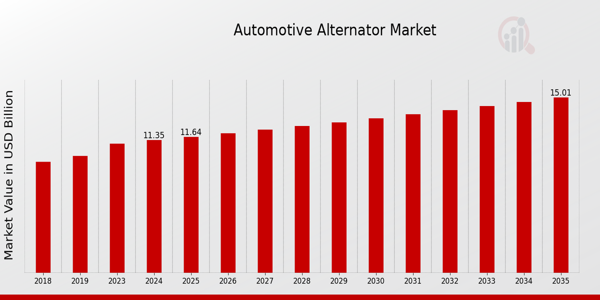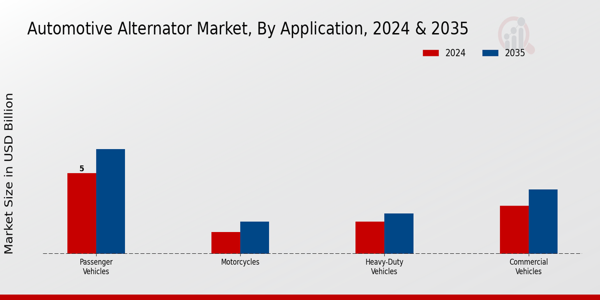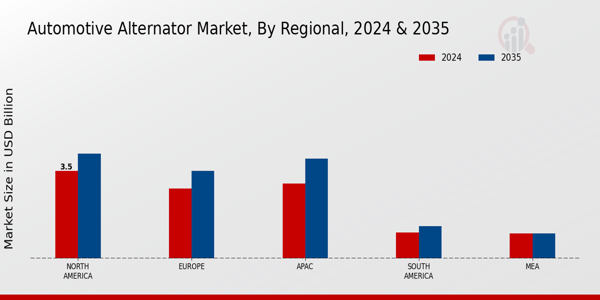Global Automotive Alternator Market Overview:
As per MRFR analysis, the Automotive Alternator Market Size was estimated at 11.07 (USD Billion) in 2023. The Automotive Alternator Market Industry is expected to grow from 11.35 (USD Billion) in 2024 to 15 (USD Billion) by 2035. The Automotive Alternator Market CAGR (growth rate) is expected to be around 2.57% during the forecast period (2025 - 2035).
Key Automotive Alternator Market Trends Highlighted
The Automotive Alternator Market is witnessing notable trends driven by the increasing demand for vehicle electrification and improvements in fuel efficiency. One of the key market drivers is the growing emphasis on reducing carbon emissions, prompting manufacturers to develop more efficient alternators that support eco-friendly vehicles. This shift towards electric and hybrid vehicles is reshaping the automotive landscape, leading to a surge in the requirement for advanced alternator technology that can efficiently support these powertrains. Furthermore, the rise in automotive production, particularly in emerging markets, is further fueling the demand for alternators, as more vehicles equate to a higher need for reliable and efficient power generation systems.
Capturing opportunities in this market can be achieved through the incorporation of advanced materials and designs that improve performance as well as the durability of alternators. Enhancements in electric vehicles and their components offer various options, like regenerative braking systems that could utilize alternators for better energy efficiency. Moreover, the growing demand for a vehicle’s aftermarket parts poses a significant opportunity to expand in order to serve the shifting sentiments of vehicle users who tend to maintain and upgrade their vehicles.
In recent times, there has been a shift towards auto manufacturers prioritizing compact and lightweight alternators, as these features contribute to improved fuel efficiency and vehicle performance. The incorporation of smart technologies into alternators, such as sensors for monitoring performance, is also gaining traction, reflecting a broader market trend toward the digitalization of automotive components. This technological advancement aligns with initiatives aimed at smart and green transportation solutions, indicating a strong shift in the Automotive Alternator Market that is set to define its future trajectory.

Source: Primary Research, Secondary Research, MRFR Database and Analyst Review
Automotive Alternator Market Drivers
-
Increasing Vehicle Production and Sales in the Automotive Sector
The Automotive Alternator Market Industry is significantly driven by the rising production and sales of vehicles worldwide. According to the International Organization of Motor Vehicle Manufacturers (OICA), car production reached approximately 92 million units in 2021, with a forecasted increase in production levels due to recovery from the pandemic. This trend indicates a robust growth in vehicle numbers, leading to heightened demand for components, including automotive alternators.
Furthermore, the automotive industry is supported by various governmental initiatives aimed at boosting manufacturing, such as subsidies and tax incentives. For instance, regions like Asia-Pacific have witnessed increased investments aimed at improving automotive infrastructure and technology, propelling the need for electrical components such as alternators. This uptrend in vehicle production is likely to lead to a significant uptick in the demand for automotive alternators, enhancing the market growth in the forthcoming years.
- Technological Advancements in Automotive Electrical Systems
Innovations in automotive electrical systems are a major driver for the Automotive Alternator Market Industry. The shift towards more sophisticated electrical systems in vehicles, especially with the rise of electric and hybrid vehicles, requires advanced alternators to meet new power demands. For example, automotive manufacturers like Toyota and Tesla are increasingly integrating high-efficiency alternators in their latest models to enhance fuel efficiency and battery life.
The U.S. Department of Energy reports that advancements in energy conversion and automation in automotive applications could lead to energy savings of 15% to 25%. This growing focus on enhancing vehicle performance through advanced electrical components is likely to create further opportunities for the automotive alternator market as manufacturers seek to improve their products to match evolving technology.
- Growing Demand for Advanced Fuel-Efficient Vehicles
As awareness of environmental issues rises, there is a growing demand for fuel-efficient vehicles, boosting the Automotive Alternator Market Industry. The United Nations Environment Programme highlights that approximately 13% of greenhouse gas emissions come from road transportation, leading to an increased emphasis on developing technologies that improve fuel efficiency. By 2030, it is anticipated that nearly 30% of all vehicles on the road will be electric or hybrid. This shift inherently increases the need for innovative alternators that can support these new technologies. Automakers like General Motors and Ford are investing heavily in electric vehicle technology, which necessitates reliable and efficient alternators, thus paving the way for growth in the automotive alternator market.
- Regulatory Support for Emission Reductions
Government regulations aimed at reducing emissions play a crucial role in driving the Automotive Alternator Market Industry. Policies like the Corporate Average Fuel Economy (CAFE) standards in the United States and the stringent Euro 6 emissions standards in Europe encourage manufacturers to produce vehicles with better fuel efficiency and lower emissions. The European Commission has set a target to reduce transport emissions by 90% by 2050, promoting the use of more efficient automotive systems, which include alternators. These regulations compel automotive manufacturers to seek superior and more efficient alternators to comply with these standards, thus spurring the growth of the automotive alternator market globally.
Automotive Alternator Market Segment Insights:
Automotive Alternator Market Application Insights
The Automotive Alternator Market segmentation based on Application reveals distinct contributions from various vehicle categories, highlighting their roles in market dynamics. In 2024, the overall market achieved a valuation of 11.35 USD Billion, with the application for Passenger Vehicles anticipated to dominate this sector, possessing a market valuation of 5.0 USD Billion. This strong performance can be attributed to the increasing demand for efficient energy management systems in personal transportation. As the market progresses towards 2035, the valuation for Passenger Vehicles is projected to reach 6.5 USD Billion, indicating significant market growth driven by innovations in vehicle technology and consumer trends favoring energy-efficient solutions.
Furthermore, the Commercial Vehicles application segment was valued at 3.0 USD Billion in 2024 and is expected to rise to 4.0 USD Billion by 2035. This growth can be linked to the rise in logistics and transportation services globally, where operational efficiency and reliability are crucial for businesses. Heavy-Duty Vehicles presented a market valuation of 2.0 USD Billion in 2024 and is projected to reach 2.5 USD Billion in 2035, capturing a significant niche due to the increasing need for durable and robust alternators that support heavy machinery and transport needs, showcasing their fundamental role in industrial applications.
Motorcycles contributed a smaller yet important portion of the market, with a valuation of 1.35 USD Billion in 2024 and projected to increase to 2.0 USD Billion by 2035. This segment illustrates an emerging trend towards lightweight vehicles and increased popularity in personal mobility solutions, contributing to a growing interest in motorcycle performance enhancements. Each segment not only enhances the driving experience but also addresses key market trends focusing on sustainability and efficiency. The diversified applications within the Automotive Alternator Market underline the broader context of market growth and technological advancements driving vehicle manufacturer strategies, presenting numerous opportunities for manufacturers and developers in this evolving industry landscape.

Source: Primary Research, Secondary Research, MRFR Database and Analyst Review
Automotive Alternator Market Type Insights
The Automotive Alternator Market is categorized into several types, including Belt-Driven, Gear-Driven, Hybrid, and Variable Speed Alternators. In 2024, the overall market reached a valuation of 11.35 USD Billion, showcasing significant growth potential. Belt-Driven Alternators are currently dominating the market due to their widespread use in conventional vehicles, directly impacting the market dynamics. Gear-Driven Alternators offer increased efficiency in compact designs, which appeals to manufacturers focused on performance enhancement.
Hybrid Alternators are gaining traction as the automotive industry shifts toward electrified powertrains, combining traditional and modern technologies to optimize engine performance. Variable Speed Alternators are expected to rise in prominence as they adapt to the varying demands of modern vehicles, allowing for better fuel efficiency and lower emissions. Overall, the segmentation of the Automotive Alternator Market reveals trends toward innovation and efficiency, driven by the increasing demand for electric vehicles and sustainable automotive technologies, along with evolving consumer preferences for more efficient power solutions in vehicles.
Automotive Alternator Market End Use Insights
The Automotive Alternator Market, particularly in the End Use segment, played a crucial role in the overall dynamics of the industry as it reached a valuation of 11.35 USD Billion by 2024. Within this segment, the market can be categorized into Original Equipment Manufacturer (OEM) and Aftermarket. The OEM sector tends to dominate the market due to the increasing demand for new vehicles and the corresponding requirement for high-quality components, which are essential for vehicle performance and efficiency. Meanwhile, the Aftermarket segment is also significant as it caters to the growing trend of vehicle maintenance and repair, driven by the increasing age of vehicles on the road.
Factors such as the expansion of the automotive industry, advancements in alternator technology, and the rising need for efficient vehicle electrical systems serve as growth drivers. However, challenges, including the fluctuation of raw material prices and competition from alternative energy sources, persist. Overall, the Automotive Alternator Market data reveals a stable growth trajectory, underscoring the importance of both OEM and Aftermarket avenues, as they present substantial opportunities for innovation and market expansion.
Automotive Alternator Market Vehicle Engine Type Insights
The Vehicle Engine Type segment within the Automotive Alternator Market reflects significant trends and growth opportunities. In 2024, the complete market was valued at 11.35 Billion USD, growing steadily with favorable market dynamics. Internal Combustion Engine vehicles continue to hold a substantial market share due to their longstanding presence and widespread adoption across various automotive applications. However, Electric Vehicles are rapidly gaining traction, driven by the increasing focus on sustainability and government incentives promoting clean energy.
Additionally, Hybrid Vehicles, which combine internal combustion engines with electric propulsion, are becoming increasingly relevant as consumers seek fuel efficiency without sacrificing performance. The market growth driven by innovation, regulatory frameworks, and technological advancements is evident, making the Vehicle Engine Type segment crucial in adapting to evolving consumer preferences and environmental challenges. The ongoing shifts toward greener alternatives present opportunities for expanding markets in electric and hybrid technologies, which significantly influence the overall landscape of the Automotive Alternator Market revenue.
Automotive Alternator Market Regional Insights
In the Automotive Alternator Market, the Regional segment plays a crucial role in shaping the overall landscape of the industry. In 2024, the Automotive Alternator Market revenue was driven by North America, valued at 3.5 USD Billion, which reflects its majority holding in the sector. Europe followed closely with a valuation of 2.8 USD Billion, capitalizing on a strong automotive manufacturing base and increasing vehicle production. APAC, with a valuation of 3.0 USD Billion, emerged as a significant player due to escalating urbanization and increasing demand for passenger vehicles.
Meanwhile, South America and MEA were valued at 1.05 USD Billion and 1.0 USD Billion, respectively, highlighting their potential growth prospects, albeit currently holding a smaller share of the market. As regions prioritize sustainable energy solutions, the automotive alternator market is expected to evolve, with established markets pushing for enhanced efficiency and emerging markets focusing on infrastructure development, creating a dynamic environment for growth and innovation in the Automotive Alternator Market industry.

Source: Primary Research, Secondary Research, MRFR Database and Analyst Review
Automotive Alternator Market Key Players and Competitive Insights:
The Automotive Alternator Market is characterized by a dynamic competitive landscape where several key players strive to establish their dominance. Driven by the increasing demand for fuel-efficient vehicles and advancements in automotive technology, companies in this market are continuously innovating and upgrading their products. The competitive insights reveal that manufacturers are focusing on enhancing their product quality while adopting sustainable practices to meet regulatory requirements and consumer expectations. Strategic partnerships, mergers, and acquisitions are common as firms seek to broaden their capabilities and expand their market reach. Additionally, the rise in electric and hybrid vehicle production is significantly impacting the way alternators are designed, leading to a shift in competitive strategies that emphasize energy efficiency and integration with electric power systems.
Denso stands as a prominent player in the Automotive Alternator Market, leveraging its vast operational network and robust technical expertise. The company's strong focus on research and development allows it to consistently introduce innovative products that cater to the evolving demands of the automotive industry. Denso's presence is underscored by a wide range of manufacturing facilities, which enables it to respond quickly to market needs and customer preferences. Its strengths include a strong emphasis on quality assurance and its ability to provide reliable and efficient alternators that contribute to improved vehicle performance. This commitment has fostered strong brand loyalty among customers and has significantly enhanced Denso's position within the marketplace.
Mahle is another significant participant in the Automotive Alternator Market, recognized for its comprehensive portfolio of automotive components and systems. The company specializes in the production of high-performance alternators designed to meet the energy demands of modern vehicles. Mahle's strengths lie in its advanced technological capabilities and its focus on innovation, which drives the development of energy-efficient solutions for the automotive sector. Its market presence is further solidified by strategic mergers and acquisitions that have expanded its reach and product offerings globally. By integrating cutting-edge technology with its existing product line, Mahle ensures that it remains competitive and relevant in the fast-paced automotive market. Key products include hybrid and electric vehicle alternators, highlighting its commitment to the growing demand for alternative energy solutions in the automotive industry.
Key Companies in the Automotive Alternator Market Include:
- Denso
- Mahle
- Hitachi Automotive Systems
- Nidec
- Magneti Marelli
- Valeo
- Remy International
- Aisin Seiki
- LeeceNeville
- Hella
- Delphi Technologies
- Toyo Denso
- Calsonic Kansei
- Bosch
- Mitsubishi Electric
Automotive Alternator Market Industry Developments
The Automotive Alternator Market has witnessed several significant developments recently. Manufacturers like Denso, Valeo, and Bosch continue to innovate and enhance the efficiency of alternators, with a focus on electric vehicle compatibility and energy management systems. In September 2023, Mahle announced advancements in their alternator technology aimed at improving sustainability and reducing carbon footprints in line with automotive emissions regulations. Furthermore, in August 2023, Hitachi Automotive Systems secured a strategic partnership with a major electric vehicle manufacturer to supply high-performance alternators, reflecting the growing demand for electrification.
In terms of mergers and acquisitions, in July 2023, Nidec completed the acquisition of a leading automotive alternator manufacturer, enhancing its market presence and capabilities. Additionally, in June 2023, Delphi Technologies announced a collaboration with Calsonic Kansei to develop next-generation alternators optimized for hybrid vehicles, illustrating ongoing consolidation and cooperation among top firms in the sector. The growing market valuation for these companies indicates an increasing investment in Research and Development, driving innovations forward while addressing market needs for efficiency and sustainable solutions. Major happenings from previous years, such as Mitsubishi Electric's commitment to enhancing automotive alternator designs in March 2022, have also shaped market trends significantly.
Automotive Alternator Market Segmentation Insights
-
Automotive Alternator Market Application Outlook
- Passenger Vehicles
- Commercial Vehicles
- Heavy-Duty Vehicles
- Motorcycles
-
Automotive Alternator Market Type Outlook
- Belt-Driven Alternators
- Gear-Driven Alternators
- Hybrid Alternators
- Variable Speed Alternators
-
Automotive Alternator Market End Use Outlook
-
Automotive Alternator Market Vehicle Engine Type Outlook
-
Automotive Alternator Market Regional Outlook
- North America
- Europe
- South America
- Asia Pacific
- Middle East and Africa
|
Report Attribute/Metric
|
Details
|
|
Market Size 2023
|
11.07 (USD Billion)
|
|
Market Size 2024
|
11.35 (USD Billion)
|
|
Market Size 2035
|
15.0 (USD Billion)
|
|
Compound Annual Growth Rate (CAGR)
|
2.57% (2025 - 2035)
|
|
Report Coverage
|
Revenue Forecast, Competitive Landscape, Growth Factors, and Trends
|
|
Base Year
|
2024
|
|
Market Forecast Period
|
2025 - 2035
|
|
Historical Data
|
2019 - 2024
|
|
Market Forecast Units
|
USD Billion
|
|
Key Companies Profiled
|
Denso, Mahle, Hitachi Automotive Systems, Nidec, Magneti Marelli, Valeo, Remy International, Aisin Seiki, LeeceNeville, Hella, Delphi Technologies, Toyo Denso, Calsonic Kansei, Bosch, Mitsubishi Electric
|
|
Segments Covered
|
Application, Type, End Use, Vehicle Engine Type, Regional
|
|
Key Market Opportunities
|
Electric vehicle adoption growth, Demand for fuel-efficient solutions, Advancements in alternator technology, Rising sales of passenger vehicles, Focus on renewable energy sources
|
|
Key Market Dynamics
|
Increasing vehicle production, rising demand for fuel efficiency, growing adoption of electric vehicles, advancements in alternator technology, stringent emission regulations
|
|
Countries Covered
|
North America, Europe, APAC, South America, MEA
|
Frequently Asked Questions (FAQ) :
The Automotive Alternator Market is expected to be valued at 11.35 billion USD in 2024.
The market is expected to grow at a CAGR of 2.57% from 2025 to 2035.
North America is projected to hold the largest market share in 2024, valued at 3.5 billion USD.
The market value for Passenger Vehicles is expected to reach 6.5 billion USD in 2035.
Major players in the market include Denso, Mahle, Hitachi Automotive Systems, and Valeo, among others.
The expected market size for Commercial Vehicles in 2035 is 4.0 billion USD.
The Heavy-Duty Vehicles segment is valued at 2.0 billion USD in 2024.
The market size for Motorcycles is anticipated to be 2.0 billion USD in 2035.
The market size for Europe is projected to be 2.8 billion USD in 2024.
The overall market is expected to reach a valuation of 15.0 billion USD in 2035.


















